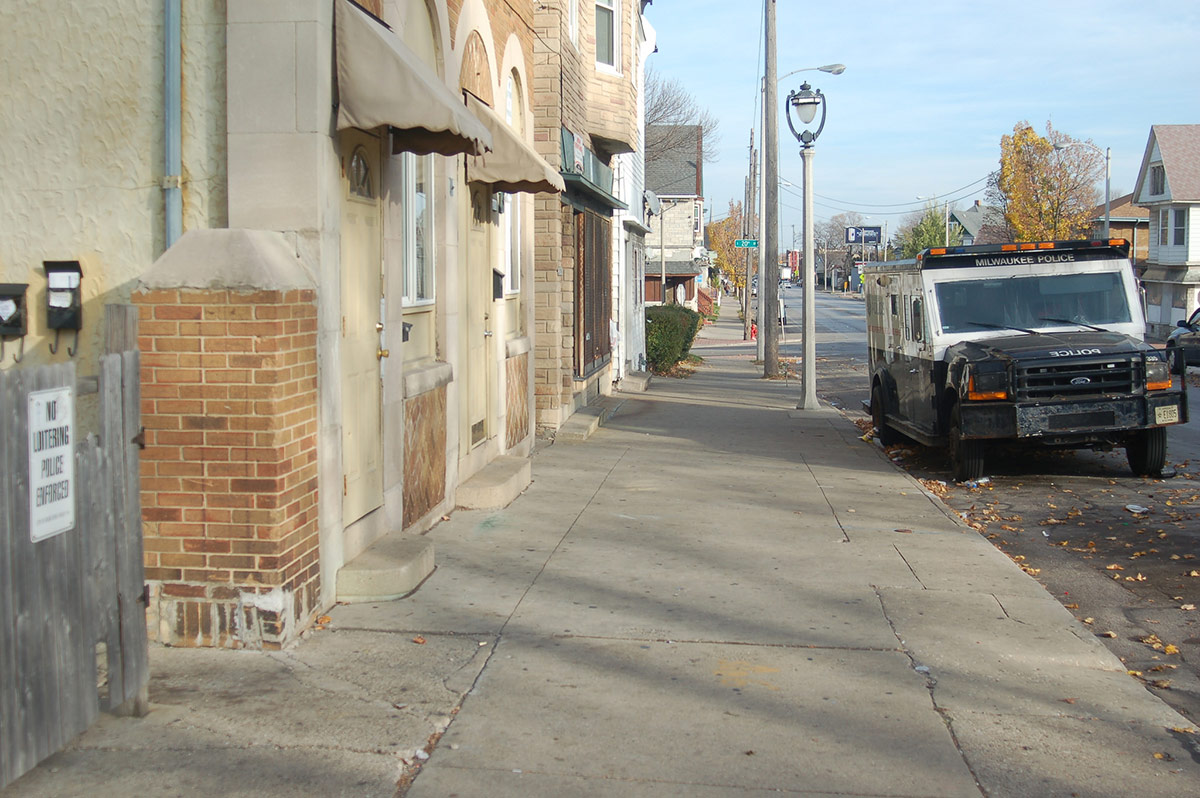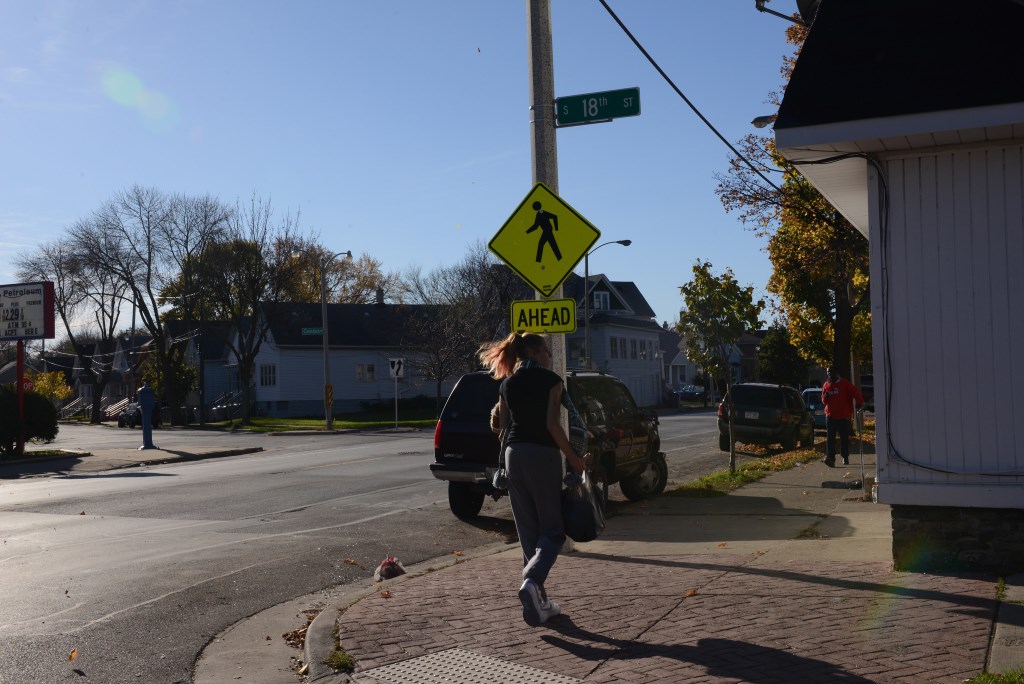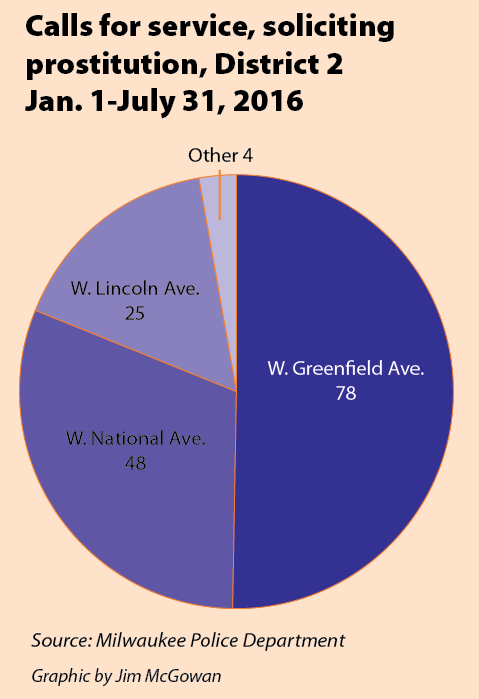The Problem of Prostitution
Greenfield Ave. is the city’s hub for sex trade, where prostitutes, residents are victimized.
For Mary Ward, who worked as a prostitute on West Lincoln and West Greenfield avenues for decades, the scenario had played itself out a thousand times before. During her date, her pimp was to show up, deliver drugs, collect money and leave. But this time, things quickly broke badly, and in the end, Ward’s john would lay lifeless in the street with two bullet holes in his head. Faced with the decision of whether to stay or run away, Ward waited for police to arrive. That was the last day she used drugs or allowed someone to abuse her body.
“That was my do or die day,” Ward said.
The shooting was just one of Ward’s many brushes with death, including the time she was kidnapped and sodomized in a car for hours.
Savage violence is a daily part of life for prostitutes, said Deanne Lawson, who sees the carnage firsthand. Lawson is executive director of the Inner Beauty Center (IBC), 1300 S. Layton Blvd.
The women come from broken homes and live broken lives, some forced into prostitution by boyfriends, parents or other family members, while others were plied with heroin, Lawson said. Many of the women who work on Greenfield Avenue were trafficked from out of state, she added. Any one of them might not have realized she was a victim of human trafficking until she stepped into a house full of women being held captive.
“There’s very high turnover,” Lawson said. “Some are here a few weeks and then they’re gone, sold like animals to pimps in other parts of the country.”
One reason why Milwaukee is a hot spot for human trafficking is the city’s central location and its close proximity to other hubs such as Chicago and Minneapolis. As for Greenfield Avenue, there’s both supply and demand.
The drugs, dope houses, pimps and johns are all there in abundance, Ward explained. “And you can go to the bodega [corner store] and buy condoms and a crack pipe,” she added.
Ward left the streets, and eventually the state, with Lawson’s help. Lawson and a team of volunteers, sometimes including city leaders such as Ald. Jose Perez, hit Greenfield Avenue on Wednesday and Friday nights, offering women dignity bags containing food and self-care supplies. Also inside each bag is a resource card with the addresses of IBC and a drop-in center on the North Side.
Last year the outreach teams made contacts with 90 different women; of those, they saw 58 only once, suggesting that they have moved elsewhere, according to Lawson.

Deanne Lawson, executive director of the Inner Beauty Center, stands next to racks of donated clothes. Photo by Edgar Mendez.
The resource card is subtle for a reason, said Lawson, as pimps and their hired associates often circle the women like vultures, providing a menacing reminder that their job is to sell their body for sex and bring money back to their handler.
While not all the women are trafficked or have a pimp, many of them do. The fear of becoming a victim of violence should they choose to quit is real.
“They’re beaten, their life is threatened or their pimp will tell them ‘I know where your mom lives, your sister lives.’ Their fears are very warranted,” Lawson said.
But some manage to escape their pimps or quit. Lawson first worked with prostitutes on Lincoln Avenue more than 10 years ago, after one came into the church she and her husband, a pastor, ran until he retired last year.
“The woman said that God told her someone there would help her,” Lawson said.
Helping women such as Ward became her mission and has radically changed her life. After her husband retired, the couple moved IBC to a location right off Greenfield Avenue, the city street with the highest number of arrests for prostitution and where half the calls to Milwaukee Police Department District 2 regarding solicitation originated during the first six months of 2016.
Once inside IBC’s drop-in center, the women are treated to a hot meal and given the opportunity to sift through donated women’s and children’s clothes. Toys are available for mothers who bring their children, and volunteer beauticians come twice a month to provide free haircuts and some pampering.
“They’re there to relax, have a hot meal and feel human again,” according to Lawson, who said most of the women are exhausted after spending nights sleeping in backyards, under boats or in garages.
If they’re ready, they’ll join group discussions aimed at helping them restore their sense of personal value.
“These women come in with no self-esteem. We try to teach them that their lives do have purpose,” Lawson said. “A lot of these women are cut off from their families and don’t feel loved by anyone.”
Public outcry
Prostitution has created another set of victims — people who live and work near Greenfield Avenue.
Public outcry about increased prostitution on Greenfield Avenue, open air drug abuse, and the needles, condoms and other paraphernalia littering residential areas full of children and families led Ald. Bob Donovan to address the issue during a September meeting of the Common Council’s Public Safety Committee.
Joel Jaeger, pastor of Christ Lutheran Church, 2235 W. Greenfield Ave., testified that day about an incident in which a prostitute was passed out face down in the street as children were being let out of Christ-St. Peter Lutheran School, which adjoins the church.
“I send my maintenance man out every other day to pick up used condoms and needles,” he added.
And when he calls police to report the problems, he said, they don’t come. “They tell me to put up a ‘no trespassing’ sign,” Jaeger said.
For women who live in the area, prostitution-related problems are more than a nuisance.
“[You] can’t even walk to the store without a guy trying to pick you up thinking you’re a prostitute,” said Marci Orosco, who lives between West Greenfield and West Scott streets.
Margie Kahn used to catch a bus on Greenfield Avenue after working her second-shift job. “I would get harassed at least three times a night. There were a couple of times that I brushed guys off and they would get out of their car and start following me,” Kahn said.
Harassment from men drove Cynthia Pinterics and her children from Greenfield Avenue after living there for only three months. “I came home and got asked if I wanted to buy drugs numerous times with my kids in the car. I called police, and they said they already know about the problem,” Pinterics said.
Much of the frustration for residents, especially parents, stems from the fact that children are being exposed to prostitution.
“Our children shouldn’t have to grow up seeing that kind of trash in our neighborhood,” said Amanda Loveridge Santiago.
Donovan, who fields numerous calls each month from constituents complaining about the activity, said during the hearing that residents were living in a “horror zone.”
Heather Wurth, District 2 police captain, acknowledged that prostitution on Greenfield Avenue has hurt the quality of life of residents there, but said police are limited in their ability to respond.
According to Wurth, to arrest people for loitering, prostitution and solicitation offenses, there has to be a “reasonable and articulate suspicion that the person has, or is about to commit a crime,” which is difficult to prove. She said that stings are labor-intensive and cost-prohibitive, adding that the public health and safety concerns that arise from prostitution cannot be addressed by policing alone.
“Prostitution and similarly related offenses are often fueled by addiction, unemployment, mental health issues, homelessness, force, coercion and/or other factors, including childhood trauma and survival tactics,” Wurth said. “Data has further shown that arrest is not an effective method to handle prostitution and cannot be the only method employed to abate these types of activities,” Wurth said.
Wurth added that there appears to be a decreasing number of addiction treatment services available and there are long waiting lists. Without treatment or jobs, she said, individuals arrested or released from jail would likely go back to the same areas and the same activities.

District 2 employs a nuisance abatement vehicle, an armored police truck equipped with surveillance cameras, on South 20th and West Greenfield Avenue. Photo by Edgar Mendez.
Data from the District Attorney’s office shows that during the three-year period from 2013-2015, 83 percent of the 1,292 arrests for prostitution in the city occurred in Districts 2 and 3. From 2011-2014, the districts represented 75 percent of the city’s arrests for prostitution.
The district employs a strategy known as PREACH (Prostitution Resource and Enforcement Action with Community Help) to combat prostitution. The strategy includes creating databases that identify known customers and pimps, coordinating with and providing information to the Human Trafficking Task Force of Greater Milwaukee, promoting awareness campaigns, strategically placing pole cameras and nuisance abatement vehicles, and sharing information about community resources. The goal of the approach is to bring stability back to neighborhoods that have suffered from prostitution and the problems that stem from it.
While this approach does at times involve increased pressure from law enforcement in the form of intensified patrolling of streets, drug dens and nuisance properties, the police are fighting an uphill battle.
According to Lawson, when a notable increase in police presence along Greenfield Avenue occurred after the Public Safety Committee hearing in September prostitution decreased, but the activity returned to normal levels after a week or two.
It is a battle that can’t be won without help, Wurth added.“Many of the prostitutes and those who solicit prostitutes live and/or work within the geographical boundaries of District 2. Greenfield Avenue, the community, its citizens and stakeholders need to make Greenfield Avenue less attractive to commit prostitution and soliciting-related offenses,” she said.
According to Tammy Rivera, executive director of Southside Organizing Committee (SOC), residents support a community-based approach to address the problem. Rivera said the SOC polled residents in the core area where prostitution occurs, near South 18th Street and West Greenfield Avenue, and 70 percent preferred diversion programs for prostitutes to incarceration. Many residents, including Kahn, said they understand that most women working the streets are not there by choice.
“I really think a lot of these girls do it because they are out of options. Not all of them are drug users,” Kahn said.
But, many of them are suffering from addiction or other illnesses, which always bothered Jelena Stojsavljevi, who managed the Speedway on South 9th Street and West Greenfield Avenue until recently.
She said the women would sometimes come in to the store right after a transaction and could barely look her in the eye. “Others were drug addicts who seemed beyond help and a few had undeniable mental illnesses,” Stojsavljevi said. “I treated them all with dignity and respect.”
Help on the way
More community resources could be available on the South Side soon. The Sisters Diversion Program, run out of the Benedict Center, 1849 Martin Luther King Jr. Drive, is looking to expand its services to Greenfield Avenue and has raised $500,000 for the expansion, according to Jeanne Geraci, the organization’s executive director. The Sisters Program was developed in response to street prostitution in 1974 and its drop-in center is open five days a week.
According to Geraci, the women often have drug addictions in addition to histories of complex trauma, and recovery necessitates a comprehensive approach that usually takes at least two years. She said the program focuses on housing, medical care, drug and substance abuse treatment, and mental health.
In District 3, on the North Side, a pilot program gives women who are arrested for prostitution the opportunity to participate in the diversion program. The women take the lead in terms of the issues they choose to work on.
“We meet people where they are. We’re trying to build trust and reduce harm to the women,” said Geraci, who added that 82 percent of the city’s prostitution-related arrests between 2012-2015 occurred in District 2 or District 3.
Geraci said her organization was encouraged to open a drop-in center on the South Side by SOC and an interfaith collaboration including the School Sisters of Saint Francis, Ascension Lutheran Church and Sinsinawa Dominican Sisters. The group hopes to match the success of its program on the North Side, where from 2012 to 2014, 45 percent of women accepted into the diversion program completed it and stayed engaged beyond the six-month minimum requirement, and 21 percent of women reported quitting prostitution within a year. In 2015, 31 percent of the women who completed the program reported quitting the sex trade.
Despite the data from the pilot diversion program, which was compiled with the help of the Medical College of Wisconsin, Donovan questioned the effectiveness of the Sisters Program during the committee hearing.
“I’ve been advised that District 3 doesn’t even send women there anymore. They go in the front door and out the back door,” he said.
Geraci acknowledged that the center is not a locked facility and women are free to come and go as they choose. But she said she doesn’t understand why Donovan doubts the program’s effectiveness, given the data.
Geraci said there are not enough residential treatment options available to deal with the magnitude of the problem in Milwaukee. The UMOS Latina Resource Center, Meta House and other organizations also provide services to victims of the sex trade on the South Side and other parts of the city, and the Benedict Center already has begun street outreach on Greenfield Avenue.
“This problem is huge,” said Donovan at the September committee meeting. “What kind of relief are we going to provide tomorrow, or the remainder of this week or next month to residents, to provide a quality atmosphere to raise a family, to conduct business?” he asked.
Some residents, angered that their children find used condoms and needles in the street or in parking lots, have taken to harassing prostitutes to drive them away.
Insulting them won’t change anything, said Lawson, who is seeking to raise funds to open IBC on additional days. “You don’t have to tell them that what they do is disgusting. They know that. They already live in shame,” Lawson said.
One change that needs to occur, according to Lawson and Geraci, is that the men who are creating the demand for prostitutes and fueling addictions with drugs need to be dealt with more harshly.
The few times buyers are caught, they’re just given a slap on the hands, said Lawson. “Our culture looks at these women as criminals and not the victims they are,” she added.
According to a February Milwaukee Neighborhood News Service report on human trafficking, arrests for soliciting a prostitute decreased from 749 in 2012 to 344 in 2014 in Milwaukee. The report quotes Sgt. Theresa Janick, who investigates human trafficking cases in the city, stating that the sheer number of people who purchase sex presents a huge challenge.
“There’s so much of it, it’s mind-blowing,” Janick said at the time. And due to that demand, said Lawson, many of the women will continue to find work.
For Ward, who was first prostituted at the age of 15, the decision to testify against her pimp in court led to death threats and forced her out of town. She said that she rarely leaves the house and suffers from PTSD. She will never be able to have a relationship or trust others, especially men, she said. But she is glad to be alive and reunited with her family, after feeling so unloved for so long. The key to helping women such as Ward quit prostitution, said Lawson, is to not give up on them.
“You continue to show them you care. To tell them things they don’t hear. That they matter, that their lives have meaning and that they are loved. The answer is not to arrest and kick them down even lower.”
This story was originally published by Milwaukee Neighborhood News Service, where you can find other stories reporting on fifteen city neighborhoods in Milwaukee.
If you think stories like this are important, become a member of Urban Milwaukee and help support real, independent journalism. Plus you get some cool added benefits.
Political Contributions Tracker
Displaying political contributions between people mentioned in this story. Learn more.
- December 20, 2015 - Robert Donovan received $100 from Joel Jaeger
- February 19, 2015 - José G. Pérez received $25 from Tammy L. Rivera























Find the people who are paying for sex and the pimps. If there are no customers, there is no prostitution.
Diane, it carries the name “the oldest profession” for goid reason. As long as there are men, there will be customers.